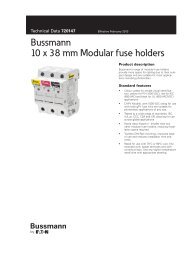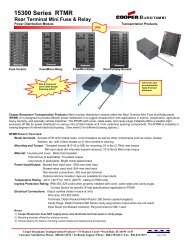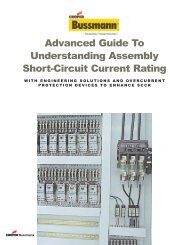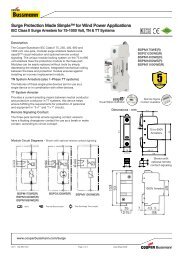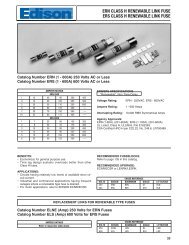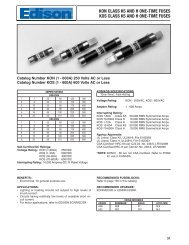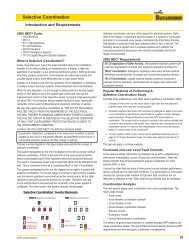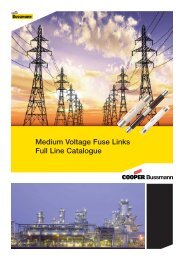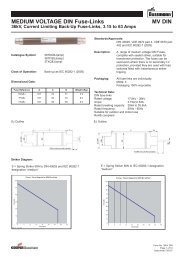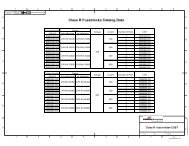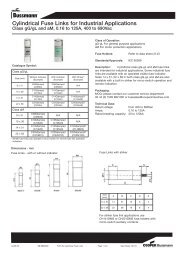Create successful ePaper yourself
Turn your PDF publications into a flip-book with our unique Google optimized e-Paper software.
Consumer Aftermarket<br />
Product Catalog<br />
<strong>Fuseology</strong>
Consumer Aftermarket Catalog<br />
<strong>Fuseology</strong> - Fuse Troubleshooting<br />
Overcurrent devices provide two main purposes in an electrical circuit:<br />
1. To protect components, equipment and associated wiring from costly<br />
damage.<br />
2. To isolate sub-systems from the main system once a current fault has<br />
occurred.<br />
Fuses and circuit breakers are commonly selected as the preferred<br />
overcurrent devices.<br />
Fuses<br />
Fuses are current sensitive devices and selected to be the weakest link in<br />
the circuit. Circuit protection is provided when the fuse link melts and safely<br />
interrupts the overcurrent demand. The key criteria to judge the<br />
performance of a fuse is the time versus current characteristic curve.<br />
This curve can be used to match the fuse with the anticipated overcurrent<br />
load expected in the application.<br />
Thermal Circuit Breakers<br />
The basic components of a thermal circuit breaker are the composite alloy<br />
reed, two precious metal contacts and the interconnecting terminals. When<br />
an overcurrent occurs, heat is generated as the current flows through the<br />
reed causing the reed to deflect and snap open. This separates the contacts<br />
and safely interrupts the current flow. Two important parameters used to<br />
judge the performance of thermal circuit breakers are the time versus<br />
current characteristic curve, similar to the fuse, along with the speed at<br />
which the contacts snap open. The relative speed at which, the contacts<br />
separate is a measure of the cycle life under electrical loading demands.<br />
<strong>Cooper</strong> <strong>Bussmann</strong> carefully designs its snap acting reed element to ensure<br />
long cycle performance for its products.<br />
Types of Overcurrent<br />
Short-Circuit: Short-circuit is a current condition that greatly exceeds the<br />
rating of the device. It is caused when a malfunction or accident creates a<br />
break in the normal path allowing electricity to flow directly to ground. This<br />
shorter current path bypasses the resistance offered by the circuit<br />
components connected in the normal current path. In this situation, there is<br />
virtually no resistance to impede the current and the current will build to a<br />
level where the heat generated can cause insulation and/or equipment<br />
breakdown.<br />
Overload: An overload is an overcurrent that is within the normal current<br />
path. Overloads occur when the current exceeds the value for which the<br />
equipment or associated wiring is rated. This typically occurs when too<br />
many devices are connected to the circuit or when a device connected to<br />
the circuit malfunctions. Sustained overloads may slowly cause overheating<br />
of the wiring and the components. The circuit protection device must open<br />
before these types of overloads cause damage.<br />
Selecting Overcurrent Protection<br />
During normal conditions, an overcurrent protection device must carry the<br />
current without nuisance openings. However, when an overload or shortcircuit<br />
occurs, the device must interrupt the overcurrent and withstand the<br />
voltage across the device after arcing. To properly select an overcurrent<br />
device, the following items must be carefully considered:<br />
Voltage Rating: Represents the maximum system voltage present in<br />
the circuit in which the overcurrent device is installed. The system<br />
voltage should not exceed this value for proper operation of the device<br />
during an overcurrent event.<br />
Current Rating: This is the amp value marked on the circuit protection<br />
device. The circuit protection device is designed to handle this value<br />
under steady operating conditions and at ambient temperatures near<br />
25°C. The current rating of the fuse should not exceed the rating of the<br />
device.<br />
Characteristics of Equipment to be Protected/In-rush Characteristics:<br />
During the operation of protected equipment, system current can<br />
significantly vary. This is particularly evident when motor or other inductive<br />
loads in the circuit cause large current surges during start-up or shutdown.<br />
A time-delay fuse should be used in applications where in-rush currents are<br />
possible.<br />
Troubleshooting Technique<br />
Important: Before replacing any fuse or circuit breaker, always turn off<br />
power, and determine and remedy the cause of the fuse or circuit breaker<br />
opening.<br />
• Always replace an open fuse with one of the same type having the correct<br />
voltage and amp rating for the application or called for by the equipment<br />
manufacturer.<br />
• Always replace a non-working circuit breaker with one of the same type<br />
having the correct voltage and amp rating for the application or called for<br />
by the equipment manufacturer. If replacing a fuse with a circuit breaker,<br />
consult your owner’s manual for recommendations.<br />
Because fuses contain no moving parts, they do not generally operate due<br />
to wear-and-tear. When a fuse opens, it's important that you determine and<br />
correct what caused the overcurrent situation in the first place. Otherwise,<br />
the replacement fuse is likely to open, too - and the circuit will still not<br />
function as intended.<br />
Automotive: Fuses are installed in one or more fuse blocks - which can be<br />
located in various locations in the vehicle, depending on its make and<br />
model. Typically, fuse panels can be found in the passenger compartment,<br />
below the steering wheel; in the engine compartment; or in some cases, in<br />
the trunk. See the vehicle owner's manual for the precise location of the<br />
fuse block(s).<br />
On most vehicles, each clip in the fuse block will be labeled, to help you<br />
identify which circuit the fuse protects (wipers, radio, dome light, etc.). The<br />
fuse itself is labeled with an amp rating, and (in the case of blade fuses) a<br />
color coding.<br />
Home: For circuits carrying 120/240 volts, please refer troubleshooting and<br />
servicing to a qualified electrician.<br />
46<br />
For product information and Data Sheets, visit www.cooperbussmann.com



